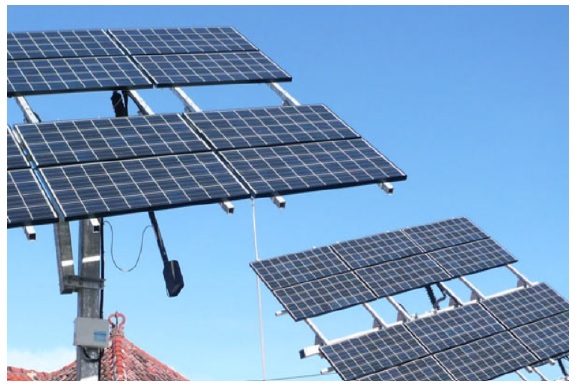Review Perkembangan PLTS di Provinsi Bali Menuju Target Kapasitas 108 MW Tahun 2025
Abstract
The central government policy through RUEN targets Bali to use 108 MWp of solar energy by 2025. Bali as a small island of highly developed tourism destinations in Indonesia is considered to have the opportunity to exploit this potential. This research tries to review how the development of PV system in Bali through literature study and field observation. The results of this study indicate that the development of total PV system installed capacity in Bali to date has reached 3.71 MWp or 3.44% of the RUEN target. Based on data managed by the development of PV system in Bali in the last 14 years it increased an average of 265.18 kWp or 7.14% annually. Until now the highest PV system capacity in Bali is in Karangasem Regency which has an installed PV system capacity of 1,106 kWp or 29.79% of the total capacity in Bali. While the lowest capacity is in Jembrana Regency with an installed capacity of 10 kWp or 0.27%. PVsystem in Bali is used in a variety of applications, the largest capacity used for utilities is 58.64%, while the lowest is used for water pumps by 0.55%. Based on the type of PV system, Bali is dominated by an on-grid PV system with an installed capacity of 3,225 kWp or 87%, while the lowest is a hybrid PV system with a capacity of 224 kWp or 6% of the total capacity in Bali.
Downloads
References
[2] Badan Penelitian dan Pengembangan ESDM, “Pembangkit Listrik Tenaga Surya (PLTS),” Kementrian ESDM, 2017.
[3] Peraturan Presiden Republik Indonesia No. 22 Tahun 2017 tentang Rencana Umum Energi Nasional (RUEN), 2017.
[4] Dewan Energi Nasional, “DEN Dorong Penyelesaian Raperda RUED Bali,” Jakarta, Indonesia: DEN, 2019.
[5] I.N.S. Kumara, I.A.D. Giriantari, W. Ariastina, dkk., “Peta Jalan Pengembangan PLTS Atap: Menuju Bali Mandiri Energi,” Bali, Indonesia: Center for Community Based Renewable Energy (CORE) & Greenpeace Indonesia, 2019.
[6] I.N.S. Kumara, “Pembangkit Listrik Tenaga Surya Skala Rumah Tangga Urban dan Ketersediaannya di Indonesia,” Bali, Indonesia: Jurnal Teknologi Elektro, 2010.
[7] ABB, “Technical Application Papers No. 10 Photovoltaic Plants,” Italy: Bergamo, 2010.
[8] I.N.S Kumara, M. Ashari, Sampeallo, A.A.G.A. Pawitra, “Simulated Energy Production and Performance Ratio of 5 MW Grid Connected Photovoltaic under Tropical Savannah Climate in Kupang Timor Island of Indonesia,” Taiwan: TAETI, 2017.
[9] A.P. Damastuti, “Pembangkit Listrik Tenaga Surya,” Bogor, Indonesia: Wacana ELLSPAT, 1997.
[10] Contained Energy, (2020) Case Studies. [Online]. http://www. containedenergy.com/case-studies/
[11] Prosol, (2020) Projects. [Online]. http://www.prosol.co.id/projects/
[12] M.R. Wicaksana, I.N.S. Kumara, I.A.D Giriantari, R. Irawati, “Unjuk Kerja Pembangkit Listrik Tenaga Surya Rooftop 158 kWp pada Kantor Gubernur Bali,” Bali, Indonesia: SPEKTRUM, 2019.
[13] Terregera Indonesia, (2020) Report of The Board of Directors. [Online]. https://investor.terregra.com/bod_report.html
[14] I.A. Medina, I.A.D. Giriantari, I.W. Sukerayasa, “Kajian dan Evaluasi Sistem Suplai Energi Listrik PLTS dan PLTB di Kampus Teknik Elektro Universitas Udayana Bukit Jimbaran” Bali, Indonesia: MITE, 2018.
[15] Direktorat Jendral Energi Baru Terbarukan dan Konversi Energi, (2020) Indonesia Power Kini Gunakan PLTS di Area Operasi. [Online]. http://ebtke.esdm.go.id/post/2020/02/26/2486/keren.indonesia.power.kini.gunakan.panel.surya.di.wilayah.operasi
[16] Dinas Penanaman Modal dan Pelayanan Terpadu Satu Pintu Kabupaten Klungkung, (2019) Monev PLTS. [Online]. https://dpmptsp. klungkungkab.go.id/2019/12/10/monev-plts/


This work is licensed under a Creative Commons Attribution-NonCommercial-NoDerivatives 4.0 International License.

This work is licensed under a Creative Commons Attribution 4.0 International License




